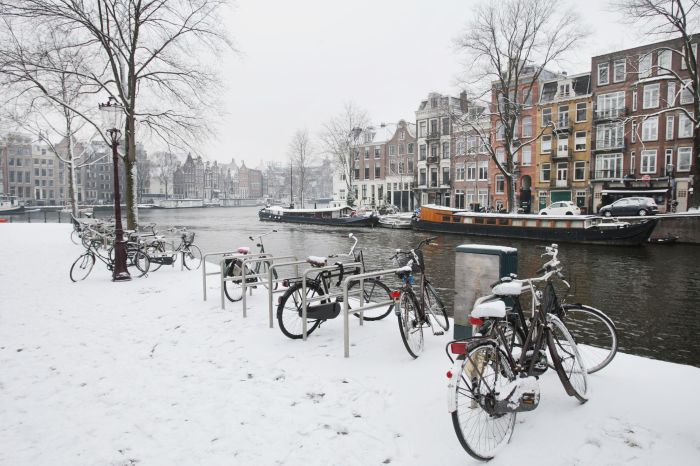Amsterdam weather, a captivating tapestry of maritime influences and seasonal shifts, paints a vibrant portrait of the city’s allure. From the gentle caress of spring breezes to the cozy embrace of winter’s chill, Amsterdam’s weather adds an enchanting layer to its captivating charm.
As we delve into the intricacies of Amsterdam’s weather patterns, we will explore the city’s unique climate classification, the profound impact of the North Sea, and the distinct seasonal variations that shape its weather throughout the year.
Amsterdam Weather Overview
Amsterdam’s weather is generally mild and temperate, influenced by its proximity to the North Sea and its location in the temperate climate zone. The city experiences four distinct seasons, with mild winters and warm summers. The weather is often characterized by high humidity and frequent precipitation throughout the year.
Climate Classification
Amsterdam’s climate is classified as a temperate oceanic climate, also known as a marine west coast climate. This climate type is characterized by mild winters, cool summers, and abundant precipitation throughout the year. The Köppen climate classification system categorizes Amsterdam’s climate as Cfb, indicating a temperate climate with warm summers and no dry season.
Influence of the North Sea
The North Sea has a significant impact on Amsterdam’s weather patterns. The warm waters of the North Sea act as a heat reservoir, moderating the city’s temperatures and contributing to the mild winters and cool summers. The proximity to the sea also results in frequent cloud cover and high humidity, leading to a relatively high amount of precipitation throughout the year.
Seasonal Weather Patterns

Amsterdam experiences distinct seasonal weather patterns throughout the year. These patterns are characterized by variations in temperature, precipitation, and sunshine hours.
Spring (March-May) brings milder temperatures, with average highs ranging from 10 to 15°C (50-59°F). Precipitation is common during this season, with occasional showers and light drizzle. The days gradually become longer, providing more sunshine hours.
Summer (June-August)
Summer is typically warm and sunny in Amsterdam. Average temperatures range from 16 to 20°C (61-68°F), with occasional heatwaves reaching higher temperatures. Precipitation is less frequent during this season, but thunderstorms can occur. The days are at their longest, providing ample opportunities for outdoor activities.
Autumn (September-November)
Autumn is a transition season, with temperatures gradually cooling down. Average highs range from 12 to 15°C (54-59°F). Precipitation increases slightly, with more frequent showers and occasional fog. The days become shorter, and sunshine hours decrease.
Winter (December-February)
Winter in Amsterdam is generally cold and cloudy. Average temperatures range from 2 to 5°C (36-41°F), with occasional cold snaps dropping below freezing. Precipitation is mostly in the form of rain or sleet, but snowfall is also possible. The days are at their shortest, with limited sunshine hours.
Amsterdam’s unpredictable weather can make planning outdoor activities challenging. If you’re seeking an adrenaline rush, consider an extreme sports vacation instead. From bungee jumping to white-water rafting, there are plenty of options to satisfy your thirst for adventure. When you return to Amsterdam, you’ll appreciate the city’s charm even more, knowing you’ve had your fill of excitement.
Precipitation Patterns

Amsterdam experiences a temperate oceanic climate characterized by moderate rainfall throughout the year. The average annual precipitation is approximately 850 millimeters (33.5 inches), distributed fairly evenly over the twelve months.
The frequency and intensity of rainfall vary seasonally. During the summer months (June to August), rainfall tends to be more frequent but less intense, often occurring in the form of brief showers or thunderstorms. In contrast, during the winter months (December to February), rainfall is less frequent but more intense, often resulting in prolonged periods of drizzle or steady rain.
Impact on Daily Life and Activities
The moderate rainfall in Amsterdam generally does not pose significant disruptions to daily life and activities. However, during periods of heavy rainfall, especially during the winter months, the city can experience localized flooding in low-lying areas. The city’s extensive canal system and efficient drainage infrastructure typically mitigate the impact of heavy rainfall, but occasional street closures or traffic delays may occur.
Despite the relatively high annual precipitation, Amsterdam enjoys a pleasant and temperate climate year-round. The moderate rainfall contributes to the city’s lush greenery and picturesque canals, which are integral to its charm and character.
Temperature Variations
Amsterdam’s temperature variations are influenced by a combination of factors, including its location, altitude, and prevailing wind patterns.
While Amsterdam’s weather can be unpredictable, one thing is for sure: the city comes alive during major sporting events. And what could be bigger than the 2026 FIFA World Cup ? With matches taking place in various cities across North America, Amsterdam is sure to be buzzing with excitement.
So, whether you’re a soccer enthusiast or just looking for a lively atmosphere, be sure to check out Amsterdam during the 2026 World Cup.
The city’s latitude, at approximately 52 degrees north, places it in a temperate climate zone. This means that Amsterdam experiences warm summers and mild winters.
Altitude and Wind Patterns
Amsterdam’s low altitude, at only a few meters above sea level, contributes to its relatively mild climate. Additionally, the city’s proximity to the North Sea and the influence of prevailing westerly winds help to moderate temperatures throughout the year.
Impact on Tourism and Outdoor Activities
The pleasant temperatures in Amsterdam make it an attractive destination for tourists throughout the year. During the summer months, when temperatures average between 15°C and 25°C (59°F and 77°F), visitors can enjoy outdoor activities such as cycling, boating, and exploring the city’s many parks and gardens.
In the winter, when temperatures average between 2°C and 7°C (36°F and 45°F), tourists can still enjoy Amsterdam’s charm, albeit with a warmer coat. Outdoor activities such as ice skating and visiting the city’s many museums and cultural attractions remain popular during this time.
Wind Patterns and Humidity

Amsterdam’s weather is influenced by its location on the North Sea coast, resulting in a maritime climate with prevailing westerly winds. These winds bring moisture and moderate temperatures to the city throughout the year.
Wind Speed and Direction
Wind speed in Amsterdam varies throughout the year, with stronger winds occurring during the winter months. The average wind speed ranges from 12 to 18 miles per hour (19 to 29 kilometers per hour), with gusts reaching up to 30 miles per hour (48 kilometers per hour) during storms.
The prevailing wind direction is from the west, bringing in moist air from the Atlantic Ocean. However, during the summer months, easterly winds can bring warmer and drier air from continental Europe.
Humidity
Amsterdam’s humidity levels are generally high, averaging around 80% throughout the year. The high humidity can make the air feel muggy and uncomfortable, especially during the summer months. The humidity levels are influenced by the city’s proximity to the North Sea and the prevailing westerly winds.
Weather Forecasting and Predictions
Accurate weather forecasts are crucial for planning outdoor activities, making travel arrangements, and preparing for potential weather-related hazards. In Amsterdam, various methods are employed to predict the weather, ranging from traditional observations to advanced computer modeling.
Numerical weather prediction (NWP) is a primary method used by meteorologists to forecast the weather. NWP involves using powerful computers to solve complex mathematical equations that represent the physical processes in the atmosphere. These equations take into account factors such as temperature, pressure, wind speed, and humidity, and simulate how these factors will evolve over time.
If you’re planning a luxury getaway, don’t miss out on our exclusive luxury travel deals. From lavish accommodations to unforgettable experiences, we have everything you need to create a truly memorable vacation. And when you’re not exploring the city’s canals or admiring its iconic architecture, you can relax in your luxurious hotel room and enjoy the breathtaking views of the city.
Accuracy and Reliability, Amsterdam weather
The accuracy of weather forecasts depends on several factors, including the availability of real-time data, the sophistication of the computer models, and the skill of the meteorologists interpreting the results. In general, weather forecasts are more accurate for the short term (up to a few days) than for the long term (weeks or months).
Short-term forecasts are typically reliable, with a high probability of being correct. However, as the forecast range increases, the accuracy decreases due to the inherent unpredictability of the atmosphere and the accumulation of errors in the computer models.
Accessing and Interpreting Forecasts
There are various ways to access weather forecasts for Amsterdam. The Royal Netherlands Meteorological Institute (KNMI) is the official weather service for the Netherlands and provides detailed forecasts on its website and through mobile applications.
When interpreting weather forecasts, it’s important to consider the following:
- Forecast confidence: Most weather forecasts include a confidence level, which indicates the likelihood of the forecast being accurate.
- Terminology: Familiarize yourself with common weather terms and their meanings, such as “partly cloudy,” “scattered showers,” and “thunderstorms.”
- Local variations: Weather conditions can vary significantly within a small area, especially in coastal regions like Amsterdam. Be aware of local weather patterns and microclimates.
End of Discussion

In conclusion, Amsterdam’s weather is a symphony of maritime influences and seasonal shifts, creating a dynamic and captivating backdrop for the city’s vibrant life. Whether you seek the warmth of summer’s embrace or the cozy charm of winter’s snowfall, Amsterdam’s weather offers a unique and unforgettable experience that adds to the city’s irresistible allure.
Q&A
What is the best time to visit Amsterdam weather-wise?
Spring (April-May) and autumn (September-October) offer the most pleasant weather, with mild temperatures and fewer crowds.
Is Amsterdam prone to extreme weather events?
While Amsterdam generally experiences mild weather, it can be susceptible to occasional storms, rainfall, and snowfall during certain seasons.
How does the North Sea influence Amsterdam’s weather?
The North Sea’s proximity moderates Amsterdam’s temperatures, resulting in milder winters and cooler summers compared to inland areas.